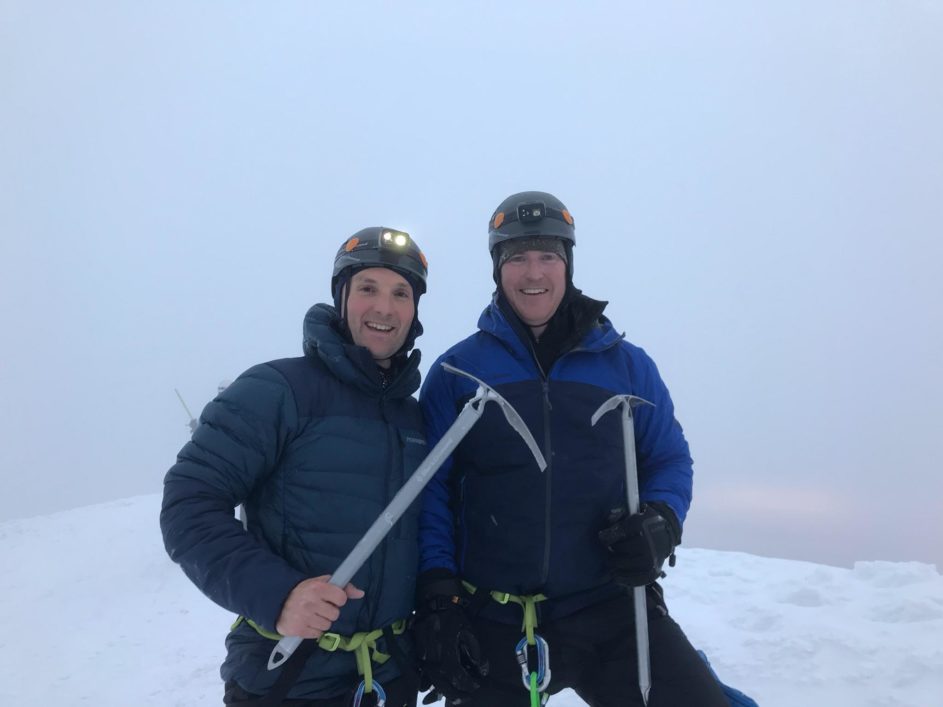David Smoak recently looked fear in the eye and tackled one of the greatest mental and physical tasks known to man. Then, after putting together Farragut’s FY2020 budget, he climbed a mountain.
Smoak is Farragut’s town administrator. He’s used to the rigors of keeping the town on track fiscally, but mountaineering is a new endeavor. After climbing the Grand Canyon with his wife, Sonya, in March 2018, he wanted a new challenge. So he invited his friend Brett Huebner to climb Mount Hood, an 11,250-foot peak in Oregon.
Mount Hood is a popular climb because it doesn’t require much technical expertise, and novice climbers can reach the summit without gear beyond ice axes and crampons (spiked iron plates worn on boots to prevent slipping on ice).
Smoak and Huebner trained by hiking in the Smoky Mountains. Once a month, they’d take on climbs like Mount Sterling and Mount Cammerer to experience elevation change and hiking with a pack. In April, they headed to Mount Arkansas in Colorado for some high-elevation training. They learned skills like snowshoeing and self-arrest (how to stop yourself with an ice axe if you fall) during a mountaineering course taught at 13,500 feet.
They flew to Portland on May 13 and checked in at the Timberline Lodge, located at 6,000 feet on the southern flank of Mount Hood. The historic hotel is best known as the setting for the 1980 film “The Shining.” The next day, they met their guide, Jared, and spent some time on the slopes practicing and checking gear.
The climbers met Jared at 1:30 a.m. on May 15. The early departure time is a safeguard against avalanches, because colder temps make the snow more stable, Smoak says. The “three Ws” – whiteout, wet and wind – can keep climbers from safely reaching the summit of Mount Hood, but conditions looked good as they began their climb at 2:30 a.m.
The first hurdle was crossing a crevasse. During winter months, the ice makes it possible for climbers to step across the deadly crevasse, but it was still nerve-wracking. “People die on that mountain every year,” Smoak says.
The climbers used poles until they reached 10,500 feet, where they exchanged poles for ice axes. When they reached the “pearly gates,” a steep, narrow chute covered in ice, they could see the glow of the sunrise. Soon, they were at the summit.
“As soon as we got to the top, we saw Mount Adams and Mount St. Helens for one minute. Then the whiteout conditions set in. We were in a complete whiteout for the rest of the day.”
They stayed on the summit for about three minutes before their guide said it was time to go. The group was pelted with blowing snow and ice as they belayed down the mountain using anchors set by Jared. When Smoak began to lose feeling in his hands and one of his crampons came loose, they quickly fixed the crampon and steadily descended down the mountain. Jared used GPS and a radio to keep the group on course, and they regained visibility at 6,500 feet.
Looking back at the experience, Smoak says he liked the feeling of accomplishing something new and getting out of his comfort zone. He admits that he’s not a huge fan of heights.
He’s also ready for the next challenge but isn’t interested in Everest. He’s researching mountains that are comparable to Mount Hood. “I’ve already got the gear,” he explains.
“Being out there in the middle of nature, away from everything in a beautiful environment, focused on the task at hand, that’s what I really enjoyed.”
Wendy Smith is public relations and marketing coordinator for the town of Farragut.

